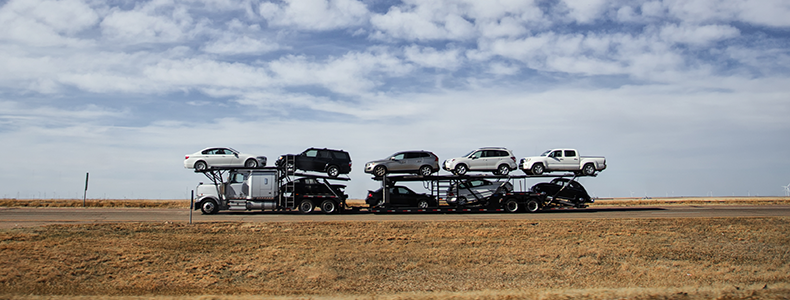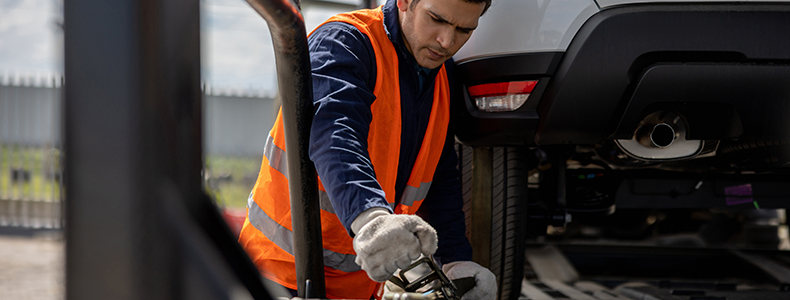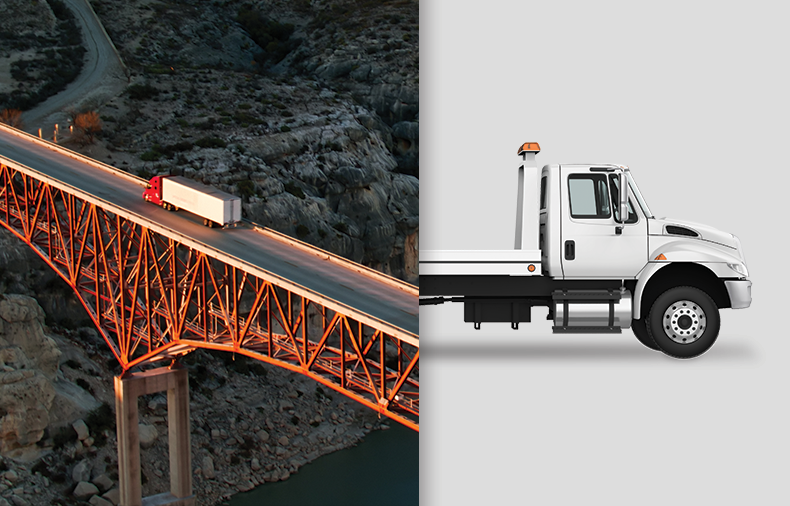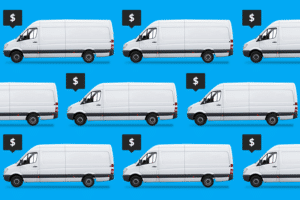When it comes to auto transport, choosing the right carrier is paramount. Your vehicle is an invaluable asset, but not fully grasping the shipping process leaves far too much room for something to go wrong. Believe us: We’ve heard the nightmare stories — from shipping delays to miscommunications.
That’s precisely why we prepared this guide. We want to shed light on the vehicle shipping process so you can make an informed decision when selecting a shipping company. At uShip, our goal is to equip you with knowledge so you can avoid mistakes and find a transport provider you can fully trust.
We’ll walk through what professional auto transport looks like, what safety measures and communication standards should be in place, the hallmarks of reliability, and reasonable pricing models. We’ll also decode some of the jargon around vehicle logistics so you can ask the right questions. Let’s dive in.
UNDERSTANDING DIFFERENT TYPES OF VEHICLE TRANSPORT SERVICES

When arranging to ship your wheels somewhere, choosing the right type of service is key. There are two primary options, open auto transport versus enclosed, each with its unique pros and cons.
OPEN CARRIER TRANSPORT
Open carrier transport uses uncovered flatbed trailers to haul vehicles securely. Racks have specialized tie-down points to strap cars in place across 6-10 spaces per truck.
Though drivers aim to minimize risks, open shipping exposes cars to road elements like rain or debris. The trade-off is a much lower shipping cost. It’s ideal for basic A-to-B transportation of personal vehicles where exposure is an acceptable concession for value pricing.
ENCLOSED CARRIER TRANSPORT
Enclosed vehicle transport offers premium shielding, with cars riding sheltered within climate-controlled semi-trailers. This removes weather and road factors entirely, preventing exterior damage during transit.
Trailers hold 5-6 vehicles comfortably in cushioned slots customizable by vehicle size. Enclosed accommodates delicate exotics, vintage rides, and high-end luxury vehicles where exposure isn’t preferable. As expected, enclosed shipping is pricier, given equipment and handling expenses, making open transport more feasible for basic transportation jobs.
DOOR-TO-DOOR VS. TERMINAL-TO-TERMINAL SERVICES
Another critical choice is the delivery method. In general, terminal-to-terminal vehicle transport trades convenience for cost savings compared to white-glove delivery. With this method, drivers meet at designated depots and must take separate car transportation to and from drop-off points. Ultimately, a little extra coordination labor translates to more affordable pricing.
On the other hand, door-to-door shipping coordinates truck dispatch directly to your location for seamless end-to-end vehicle retrieval and delivery. It’s ideal for those who want a premium service experience with zero consumer effort required.
SPECIALIZED TRANSPORT FOR LUXURY OR CLASSIC VEHICLES
Don’t overlook specialty carriers for high-end luxury or classic vehicles requiring white-glove, enclosed transport services. These services cater to temperamental vintage cars and seven-figure supercar pedigrees, with experienced carriers shipping delicate high-performance machines across state lines.
These transport specialists use enclosed trailers and custom equipment like hydraulic lifts and floor blanket padding. As expected, you’ll need to pay a premium for specialty services and peace of mind.
Not sure which specialty service is right for your vehicle? Striking the best balance between priority and pricing takes research and forethought, but doing diligence means smoothly transporting the household minivan and prized Aston Martin alike.
KEY FACTORS TO CONSIDER FOR VEHICLE TRANSPORT
When it comes to choosing the right shipping provider, there are several key factors to consider. The top aspects to focus on are:
COST AND BUDGETING
The first question for most customers is, “How much will this cost me?” Vehicle transport costs vary based on these key factors.
To get a more accurate estimate tailored to your shipping needs, we recommend creating a free listing on uShip. By providing details about your vehicle and shipping requirements, you’ll receive quotes from our network of feedback-rated carriers. These quotes will give you an idea of the estimated costs for your car shipment.
However, costs can surge if you have special requirements like a classic car or motorcycle needing white-glove treatment.
- Transport Style: Enclosed trailers typically run more expensive than open transport trailers. Open transport quotes are the cheapest.
- Mileage: Extra mileage means inflated gas, equipment wear-and-tear, and driver pay, resulting in additional costs.
- Vehicle Size: Large trucks and SUVs occupy more trailer space, limiting the total vehicle volume hauled per trip. Expect to pay a size premium for shipping outsized items.
- Seasons and Timing: Peak seasons like summer see upticks in consumer moves, increasing transport demand. More volume means carriers can charge top dollar. Meanwhile, transporting during off-months can help you secure modest discounts.
- Expedited Service: If you’re in a rush, expect to pay a premium for quick-turn transit, sometimes double the standard quote. Last-minute relocations or purchases call for premium 5-star treatment.
Pro Tip: Build contingencies into your budget to cover potential fees for door-to-door pickup, residential unloading, waiting time, and damage claims. Avoid surprises by allotting an extra 10-20% buffer in your vehicle transport budget.
SAFETY AND INSURANCE COVERAGE
When choosing an auto transport company, safety should be a top priority. Take the time to review carriers’ safety certifications and inspection records.
Requirements to ask about include:
- DOT Numbers: All interstate carriers must be registered with the Department of Transportation. Check that the company and drivers have valid DOT numbers, indicating that they’ve met licensing requirements.
- Commercial Truck Inspections: Ask to see records of annual truck inspections required by the DOT. Look for recent reviews with no significant violations or failures that could impact safety or operations.
- Insurance Paperwork: Avoid using a carrier that cannot provide current insurance certificates. Valuable vehicles may require upgraded coverage beyond primary liability, so discuss options to match policy limits to your car’s value.
- Accident History: Review the company’s accident rates over the past three years.
Pro Tip: Vetting these safety components reduces risks during transport, so take the time to understand and validate carrier qualifications, confirm your vehicle remains incompetent, and secure hands from pickup through final delivery.
REPUTATION AND REVIEWS
A transport company’s reputation speaks volumes about their service consistency and professionalism. Seek third-party validation through reviews, referrals, and industry-specific platforms:
- Customer Reviews: Review a carrier’s previous customer reviews on their uShip profile to gauge their reputation and vehicle delivery history.
- Online Ratings: Search the company’s name on websites like TransportReviews and Google My Business, which host consumer feedback. Look for overall 4-5 star ratings and a substantial majority of positive reviews.
- Resolution History: Issues can occasionally occur even among suitable carriers. Scan comments on how responsive they were in addressing problems that arose rather than avoiding accountability.
Pro Tip: Cross-validating flattering reviews and grievances present a balanced picture of strengths and weaknesses when entrusting your vehicle into a carrier’s care.
TIMING AND DELIVERY
Auto transport timelines vary by carrier type and transport distance, generally following industry averages:
- Enclosed Trailers: Enclosed transport can take anywhere from a few days to a few weeks, depending on distance and carrier availability.
- Open Carriers: Open transport can take anywhere from a few days to a few weeks, depending on distance and carrier availability.
Pro Tip: Plan for realistic time-in-transit estimates and cushion an extra 7-10 days as a buffer should weather, mechanics, or paperwork delays disrupt schedules mid-route. Reputable carriers provide shipment status updates to inform you if ETAs need to shift.
WHY SHOULD YOU PREPARE YOUR VEHICLE FOR TRANSPORT?
Preparing your vehicle before transport is essential for several key reasons:
- Safety: Properly securing the vehicle and removing loose items prevents hazards during transport. Things shifting can destabilize the car, while unsecured hoods/doors are road debris hazards. Preparation minimizes these risks.
- Vehicle Integrity: Securing battery cables, strapping doors/hoods shut, and removing loose parts protects against vibration damage and road debris that could dent/scratch the vehicle. This maintains the structural and cosmetic integrity of the car during transport.
- Transport Rules: Carriers have rules about vehicle fluid levels, loose objects, loading weight, and tie-down requirements. Following these rules ensures your vehicle is accepted for transport and is appropriately secured along the journey. Non-compliance could prevent transport.
- Theft Prevention: Removing valuables and personal information documents from the vehicle compartments prevents theft during transport when the vehicle is out of your possession between origin and destination.
- Ease of Loading/Unloading: A clean vehicle that’s easy to roll/steer and has good visibility simplifies transport loading. Similarly, cleaning inside simplifies unloading and inspecting the car for new damage at the destination point.
HOW TO PREPARE YOUR VEHICLE FOR TRANSPORT

Preparing your vehicle for transport is crucial to ensure a smooth and secure shipping process. Here’s are some comprehensive tips on how to prepare your vehicle for transport:
- Clean out the vehicle’s interior and exterior. Vacuum carpets, wipe down surfaces, remove loose items, and wash the body to maximize visibility.
- Check and top up fluid levels. Check the engine oil, transmission fluid, power steering fluid, brake fluid, coolant, and washer fluid. Use manufacturer-recommended types.
- Check the tire pressures and tread depth. Inflate tires to door jamb sticker recommendation. Ensure tires have adequate tread for the journey.
- Disconnect the battery to prevent battery drain. Disconnect the negative terminal first, then positive. Then, wrap the terminals to prevent accidental reconnection.
- Secure the hood and doors that won’t latch properly. Use ropes, straps, or moving blankets to securely fasten them to the vehicle.
- Remove or secure loose exterior parts. Secure the grills, air dams, and spoilers. Store any loose parts inside the car or secure parts of the vehicle if you’re unable to remove them.
- Drain fuel to 1/4 tank. Draining the fuel helps to reduce the weight and potential fire hazards. Add fuel stabilizer to prevent degradation.
- Remove any personal items. Ensure no personal items, electronics, or cash are left inside the vehicle and account for keys. Lock the car.
- Document your vehicle’s condition. Take photos of the odometer and existing exterior damage for reference later if needed.
- Attach a “do not start” warning sign. Adhere to the warning sign on the dashboard and keep the battery disconnected. Leave the gear shift in Park.
WHAT TO EXPECT ON THE DAY OF TRANSPORT
Knowing what to expect removes surprises on transport day and helps the shipment process go smoothly. Let the company know if you have any other questions ahead of time. Here’s what you can expect:
- Transport Driver Inspection: The transport truck driver will do a walk-around inspection of your vehicle, checking for pre-existing damage, proper preparation done, fluid leaks, etc., before loading.
- Loading Process: The driver will start your vehicle and make it drivable if the battery is disconnected. They may load your vehicle onto a carrier truck or trailer via ramps.
- Paperwork: The carrier will need your signature to confirm the vehicle’s condition and authorize shipment. Review any paperwork thoroughly before signing, and be sure to keep copies for your records.
- Transport Mode: Your vehicle may be shipped either open or enclosed. Open means exposed to road elements on a trailer, while enclosed is inside a covered trailer.
- Point of Contact: Get the driver’s mobile number and truck details in case the company needs routing info or updates about potential delays during transport.
- Delivery Timeline: Confirm the delivery date/location with the company and notify them early about any changes to your drop-off point or contact information during shipment.
- Unloading: Be present at the destination during unloading to inspect for new damage. Thoroughly review as the transport company is only liable for damage incurred during transport/loading.
COMMON PITFALLS TO AVOID WHEN TRANSPORTING YOUR VEHICLE
Whether you’re transporting your vehicle overseas or to another city, here are some common pitfalls to avoid during the shipping process.
LEAVING PERSONAL ITEMS IN THE VEHICLE
Never leave cash, electronics, or personal documentation in a vehicle you’re shipping. Despite background checks, theft occasionally happens with transported vehicles left briefly unattended during multi-pickup routes. Avoid this by removing valuables and locking the car. Leave no signs of what may be inside.
FAILING TO NOTE PRE-EXISTING DAMAGE
Without photographic evidence of any scratches, scrapes, or dents your vehicle had before transport, proving that any damage occurred during shipping becomes much more challenging. Avoid potential issues by walking around and noting everything visible on the pre-shipping checklist. Ask the carrier to countersign it before shipping.
NOT CHECKING FLUIDS OR TIRE PRESSURE
Transport puts stress on vehicles, and low fluids or under-inflated tires are more prone to damage en route. Avoid breakdowns or blowouts by ensuring everything is topped up before transporting your car. Do a multi-point inspection of all vehicle systems per your checklist.
TRUSTING VERBAL AGREEMENTS
Some contracts promise more verbally than companies are liable to deliver. Legally, the written terms stand. To avoid frustration, understand the limits of liability and timing commitments in your signed quote before agreeing to anything verbally that seems unclear or too good to be true.
WHY CHOOSE USHIP FOR YOUR VEHICLE TRANSPORT NEEDS?
At uShip, we provide access to a vast network of carriers so you can choose a transporter that aligns with your specific needs and budget. No matter what your shipping needs look like, you can count on us as your trusted shipping partner.
- Unparalleled Scale and Choice: uShip gives you access to over 35,000+ carriers. We offer unmatched carrier options tailored to any shipment need, from motorcycles to vintage items to boats.
- Empowered Customer Experiences: You’re in control through transparent carrier profiles, ratings, and transparent pricing.
- Security and Peace of Mind: We offer real-time status updates for total visibility once booked.
- Valued Business Partners: From Etsy to eBay motors, it’s easy to see why so many big names in the business trust uShip for their big and bulky shipping needs.
- Simple End-to-End Platform: Our online platform conveniently consolidates the entire transport process—from listing, carrier matching, and tracking to verified payments and responsive support.
WRAPPING UP
Choosing the best vehicle transport carrier is crucial to avoid problems. With over 795,000 shipments in 2022 spanning a 35,000+ transporter network, uShip offers unprecedented choices tailored to any cargo, vehicle, or equipment transport need. Our automated matching technology and double auction model empower customers through transparent, competitive bids.
Ready to experience worry-free shipping? Connect with top-rated carriers right from your fingertips with uShip in seconds. It’s that simple!
FREQUENTLY ASKED QUESTIONS (FAQS)
WHAT’S THE SAFEST WAY TO TRANSPORT A VEHICLE?
The safest option is enclosed auto transport. Enclosed trailers protect vehicles from weather and road debris during transit. Open carriers without coverage can also be secure if carriers use proper precautions.
HOW MUCH DOES IT TYPICALLY COST TO SHIP A CAR?
The cost to ship a car can vary based on factors like the vehicle’s size, distance, and type of transport. On average, it can range anywhere from a few hundred to a few thousand dollars.
WHAT’S THE DIFFERENCE BETWEEN OPEN AND ENCLOSED CAR TRANSPORT?
Open carriers use uncovered trailers to haul vehicles exposed to elements, but costs are lower. Enclosed trailers offer covered protection from weather and road factors for delicate vehicles.
HOW DO I PREPARE MY CAR FOR SHIPPING?
To properly prepare your car, clean inside and outside, check fluid levels, inflate the tires, disconnect the battery, remove or secure loose parts, take photos of existing damage, and remove personal items and valuables.
WHAT SHOULD I LOOK FOR IN CARRIER REVIEWS?
Check to see if previous customers have described issues being resolved fairly and responsively. Look for ratings over four stars and the most positive feedback on service quality.
HOW LONG DOES IT TAKE TO TRANSPORT VEHICLES ACROSS THE COUNTRY?
Typically, it can take 1 to 2 days from pickup to delivery for in-state transport and 2 to 7 days for cross-country transport.
CAN I SHIP PERSONAL ITEMS IN MY CAR DURING TRANSPORT?
It’s not recommended to leave valuables in an unattended vehicle during transit. Carriers typically advise removing or securely stowing out of sight any personal items during shipping.
WHAT ARE THE RISKS OF TERMINAL-TO-TERMINAL VEHICLE SHIPPING?
The main risks are delays if the car isn’t dropped off/picked up on schedule since you handle transportation to and from the depot. Any exterior damage that occurs is also your responsibility during self-transport.
Want to see how much it would cost to ship your car?



